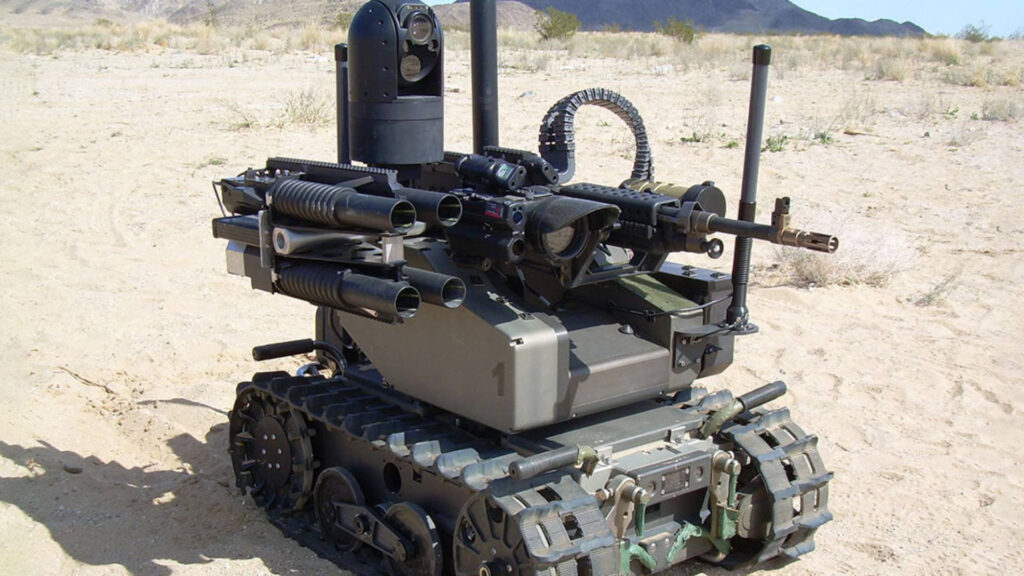
There is no one universally agreed definition of Artificial Intelligence (AI). However, a general, albeit oversimplified definition of AI is the capacity of a computer system to perform tasks that typically require human intelligence, such as visual observation, decision making and speech recognition. Future war fighting is envisaged to pivot towards human-machine groups working in concert, both in the physical and virtual sense. This is because, the use of advanced and networked technologies on the battlefield is increasing. The Military Robots and Autonomous Systems (MRAS) strategy of several armed forces around the world enunciates how the army, navy and air-force seeks to leverage evolving technology such as Artificial Intelligence (AI), autonomy and robotics as they develop, in order to gain asymmetric benefits. MRAS covers a comprehensive range of integrated technologies that includes among other unmanned ground systems, unmanned aerial systems, self-learning machines and intelligent systems that can make logical deductions of their environment. The heightened use of MRAS competencies will revolutionize the way militaries fights by:
(a) intensifying situational awareness,
(b) easing the soldier’s physical and cerebral workloads,
(c ) expanding support, simplifying movement, and
(d) augmenting reach and force protection.
In turn, this will afford commanders on the ground new prospects and potentially, substitute soldiers in some of the riskiest tasks in the battle space. MRAS technology will also offer noteworthy opportunity in the training and education of soldiers to advance learning and provide worthwhile and pragmatic training.
Advancement of Military Robots and Autonomous Systems
Early in this decade, the coming together of three major enabling technologies — big data, improved machine learning approaches and growth of computer processing power, advanced the state of Narrow AI, which describes algorithms that deal with specific challenges like game playing, navigation and image recognition. All the current AI systems fall into the Narrow AI category. We will witness entirely automated autonomous systems in the near future potentially making the function of human soldier passé. Being “autonomous” has different connotations in different fields of study. Consequently, in terms of military weapon development, the classification of a weapon as autonomous is not as clear-cut as in other areas. The particular standard involved in the perception of being autonomous can differ hugely between different academics, nations and organizations. The aim is for military robots and autonomous systems to acquire a common understanding of the environment with the soldier and conduct autonomous maneuvers.
Generally speaking, there are 3 types of military robots and autonomous systems. These platforms are Land based, Air based and Sea based.
1. Land Based Platforms: Military robots and autonomous systems that functions while in contact with the ground and without an onboard human presence.
2. Air Based Platforms: An aircraft without a human pilot on board that maybe either autonomous or semi-autonomous.
3. Sea Based Platforms: Unmanned Underwater Vehicles (UUVs) that are able to function underwater without a human occupant. These UUVs may be separated into the two types —
(a) remotely operated underwater vehicles (ROUVs), which are controlled by a remote human operator, and
(b) autonomous underwater vehicles (AUVs), which operate without any direct human input.
Role of the State
The fundamental choice for policymakers globally, is clear. Bigger spending for the purchase of military robots and autonomous systems, basically serves three conceivable objectives: superior upgrading for the future, elevated unit-by-unit alacrity for today, and enhanced force size and structure of the country’s armed forces.
When it comes to military robots and autonomous systems cost is a major factor. The costs for developing a AI enabled autonomous system are regularly apportioned between development and production and operations (P&O). Costs in the development stage are propelled powerfully by test costs. Hardware testing of full-scale testing is awfully steep comprising the production price of the test unit and the price of the test facility integration, process and overhaul. Likewise, software testing in an integrated hardware facility also increases costs. In this case, costs like, the cost of the flight avionics and authenticated simulation models are key drivers. Additional cost drivers involve transportation system improvement for full scale phases, ground support equipment at the facility and any manufacturing capability development.
Defense Primes and the Development of Innovative AI Solutions
In order to keep up with market requirement, major aerospace and defense primes expect the deployment of innovative solutions across the value chain including launch, manufacturing, and supply chain. In such a growing market it will be judicious for players both big and small to develop long-term sustainable collaborations to uphold and create a robust business.
Future military robots will require intelligence, insight and robustness. They must be competent enough to flawlessly use whatever processing power they have at any point of time and be capable enough to understand when it makes sense to advance towards a target via a less-than- ideal path to evade enemy contact, exactly the same way a soldier does. Another objective is to build military robots that can combat and win against near-peer antagonists. The aim is to have a dozen or so military robots operated by a single human being. Researchers are inserting artificial intelligence and machine learning capacities to robots because it’s impractical to hard code every distinct situation they might face.
Military robots and autonomous systems will need to be versatile enough to function not only in extremely amorphous environments, but also in locations where adversaries might be aggressively trying to terminate them. Discerning how to get rid of a number of conjectures that occur in a lot of AI enabled commercial systems and put them into platforms in the military environment is very important for the military.
Decision Making in the Age of Military Robots
Of particular significance will be deliberating on the influence of military robots and autonomous systems that can enhance the speed and precision of the human decision-making cycle to produce tempo. This will necessitate ingenuity and suitable risk-taking tactics.
Armed forces around the world need to contemplate what transformations will need to occur to policy, perceptions and force design to sustain the use of MRAS capabilities. This will involve adjusting current acquisition procedures to be more responsive to make sure armed forces can keep up with the swift rate of technology progress and perfection. Armed forces should patronage invention through prototyping, research, and exploiting the scientific intelligence of the existing workforce. In this background it will take time to acquire, polish and acclimatize to fighting with and through MRAS.
AI will improve the capacity for MRAS to function self-sufficiently in errands such as off-road driving and examining and dealing with copious amounts of data for easy human decision-making. Gradually, AI will account for operational aspects such as mission factors, rules of engagement, and comprehensive terrain evaluation. As human-machine collaboration matures, AI will influence faster and improved decision-making apart from enhancing the behavior of specific defensive assignments in which functions of speed, quantity of information, and harmonization might overpower human decision making.
